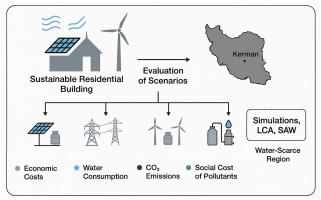Life cycle assessment and SAW-Based ranking of renewable electricity and hydrogen production scenarios for sustainable residential architecture: A case study in kerman, Iran
IF 9.4
1区 工程技术
Q1 ENERGY & FUELS
引用次数: 0
Abstract
The increasing demand for sustainable energy and the need to reduce environmental pollutants highlight the importance of renewable resources. This study evaluates four scenarios for electricity and hydrogen production in a sustainable residential building in Kerman. Using HOMER software, life cycle assessment, and Simple Additive Weighting (SAW) method, it comprehensively assesses economic and environmental indicators. The criteria include economic cost, water consumption, CO2 emissions, and social cost of pollutants. Results show that the Photovoltaic panel (PV)-Grid-Reformer scenario has the lowest cost ($168,180), while the PV-Wind Turbine (WT)-Grid-Reformer-Electrolyzer scenario has nearly double the cost. Regarding water consumption, the WT-Grid-Reformer scenario records the lowest value at 22,444,474 L, with the fourth scenario consuming 8.2 % more. Environmentally, the PV-WT-Grid-Reformer scenario achieves the lowest CO2 emissions (−1,420,200 kg), while the PV-WT-GridReformer-Electrolyzer scenario shows the highest (44,040 kg). The best and worst social costs are -$37,041 (PV-WT-Grid-Reformer scenario) and $1148 (PV-WT-GridReformer-Electrolyzer scenario), respectively. Sensitivity analysis and SAW ranking reveal that the first scenario is optimal in cost-centered conditions, whereas the third scenario ranks first when considering environmental concerns, balanced criteria, and water sensitivity. Overall, integrating solar and wind with a reformer appears ideal for minimizing pollutants and social costs, while the use of electrolyzers, due to their high cost and water demand, is less suitable for arid regions like Kerman. Additionally, a Monte Carlo sensitivity analysis with 5000 iterations confirmed the robustness of the SAW-based ranking, showing that the PV–WT–Grid–Reformer scenario ranked first in over 74.5 % of cases, highlighting its consistent superiority across varying decision-making preferences.

可持续住宅建筑的可再生电力和氢气生产方案的生命周期评估和基于saw的排名:伊朗kerman的案例研究
对可持续能源日益增长的需求和减少环境污染物的需要突出了可再生资源的重要性。本研究评估了克尔曼可持续住宅建筑中电力和氢气生产的四种情景。采用HOMER软件、生命周期评价和简单加性加权(SAW)法,对经济指标和环境指标进行综合评价。这些标准包括经济成本、水消耗、二氧化碳排放和污染物的社会成本。结果表明,光伏板-并网转化器方案的成本最低(168,180美元),而光伏-风力发电机组-并网转化器-电解槽方案的成本几乎翻了一番。用水量方面,WT-Grid-Reformer场景的用水量最低,为22,444,474 L,第四种场景的用水量高出8.2%。在环境方面,PV-WT-Grid-Reformer方案的二氧化碳排放量最低(- 1,420,200 kg),而pv - wt - gridreformer -电解槽方案的二氧化碳排放量最高(44,040 kg)。最佳和最差的社会成本分别为- 37,041美元(pv - wt -电网改造方案)和1148美元(pv - wt -电网改造成型-电解槽方案)。敏感性分析和SAW排名表明,在以成本为中心的条件下,第一种方案是最优的,而在考虑环境问题、平衡标准和水敏感性时,第三种方案排名第一。总的来说,将太阳能和风能与一个转化器结合起来,似乎是最大限度地减少污染物和社会成本的理想选择,而使用电解槽,由于其高成本和水需求,不太适合像克尔曼这样的干旱地区。此外,5000次迭代的蒙特卡罗灵敏度分析证实了基于saw的排名的鲁棒性,显示PV-WT-Grid-Reformer场景在超过74.5%的情况下排名第一,突出了其在不同决策偏好中的一致性优势。
本文章由计算机程序翻译,如有差异,请以英文原文为准。
求助全文
约1分钟内获得全文
求助全文
来源期刊

Energy
工程技术-能源与燃料
CiteScore
15.30
自引率
14.40%
发文量
0
审稿时长
14.2 weeks
期刊介绍:
Energy is a multidisciplinary, international journal that publishes research and analysis in the field of energy engineering. Our aim is to become a leading peer-reviewed platform and a trusted source of information for energy-related topics.
The journal covers a range of areas including mechanical engineering, thermal sciences, and energy analysis. We are particularly interested in research on energy modelling, prediction, integrated energy systems, planning, and management.
Additionally, we welcome papers on energy conservation, efficiency, biomass and bioenergy, renewable energy, electricity supply and demand, energy storage, buildings, and economic and policy issues. These topics should align with our broader multidisciplinary focus.
 求助内容:
求助内容: 应助结果提醒方式:
应助结果提醒方式:


